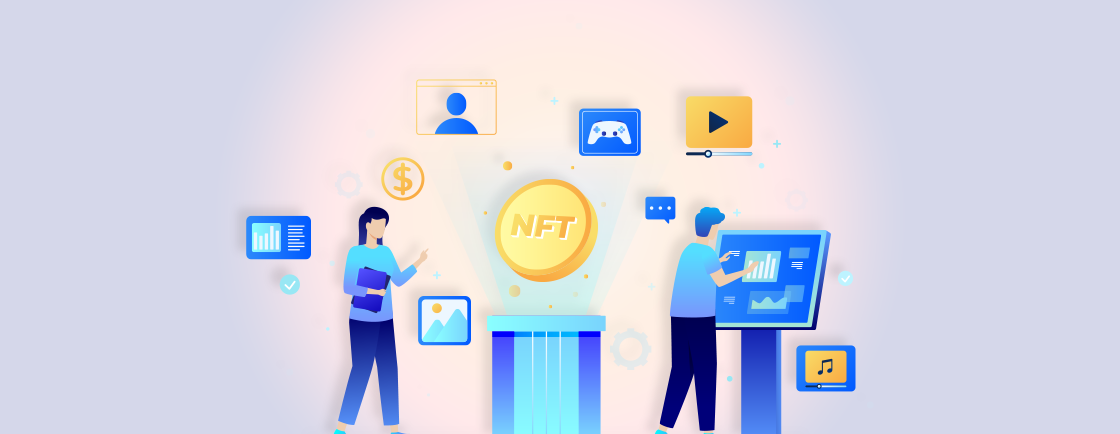Table of Contents
One of the most significant tools used by every web development company is an IDE. It provides a platform with features such as a code editor, compiler, debugger, and build tools.
Integrated Development Tools, or IDEs, help improve productivity with their intelligent code completion and syntax highlighting features. Plus, they enable developers to quickly locate and fix errors during testing and debugging. Moreover, these tools offer version control integration, allowing developers to collaborate on projects without conflicts.
Seeing as we use the IDEs on a daily basis, I thought of compiling a comprehensive guide to provide you with a variety of information on these tools. That includes the benefits, features, selection strategy, common types, setup and configuration, and much more.
But first, let’s see what an IDE is.
What is IDE?
An IDE, short for Integrated Development Environment, is a software tool that provides tons of features for software development. It packs source code editors, compilers, debuggers, and build automation tools into one.
Using an IDE has many advantages. It boosts productivity by giving developers a single space to code, edit, and manage. Plus, its built-in debugger makes troubleshooting simpler. It also offers version control integration and code completion, improving the development process.
To make the most of an IDE, here are some tips:
- Learn keyboard shortcuts: IDEs have many shortcuts that can speed up coding.
- Use plugins and extensions: Plugins can provide extra functionality to an IDE.
- Customize the layout: Change the user interface layout to optimize your workspace.
- Use integrated documentation: Built-in documentation tools provide access to language references, libraries, APIs, etc.
By following these suggestions, developers can use an IDE more efficiently. This integration of development tools simplifies workflow processes and promotes collaboration among team members, ultimately contributing to the success of software projects.
Importance of IDE in Programming
The need for an Integrated Development Environment (IDE) in programming is undeniable. IDEs provide an orderly workspace for programmers to boost productivity and make coding simpler.
IDEs come with features like code completion, syntax highlighting, and debugging tools. These features aid coders by saving time and avoiding errors with real-time advice and warnings. Plus, many IDEs come with built-in version control systems. This makes it easy for developers to monitor changes and work together as a team, reducing the risk of code issues.
Integrated Development Environments are also special as they can integrate with multiple programming languages. This means they can be used for various projects, from web dev with HTML and CSS to complex algorithms with Java or Python.
I’ll try to explain to you the value of IDE in another way. In my early days in this field, I was building a complex web app for a company. At first, I was working without an IDE, due to which I was having difficulty organizing the project components.
But when I switched to a web dev IDE, the workflow improved, I could find bugs quicker, and I could collaborate better with my colleagues.
That meant I completed the project earlier than expected and was rewarded by the company. So, you can also use the IDEs for productivity.
Common Features & Functionalities of IDEs
To understand the common features and functions of IDEs, we’ll explore their key components, like code editor, compiler/interpreter, debugger, and built-in libraries and tools. Let’s see how each of them facilitates an efficient and seamless development environment.
Code Editor
A code editor is a fundamental component of an Integrated Development Environment (IDE). It’s the part of the IDE where web developers write, edit, and manage their source code. For the best results, many businesses choose to hire web developers who can efficiently leverage these tools. Here’s how it helps with the web development process:
- Code Editors can highlight syntax with different colors and fonts, making elements like keywords, variables, and comments easier to identify. This helps readability and reduces potential errors.
- They also have auto-completion or code suggestion features. As developers type, the editor suggests code snippets based on the language’s syntax. This saves time and helps avoid mistakes.
- Search and replace functions are also available. Developers can locate lines of code or variables within large projects quickly. They can also modify multiple occurrences at once, which streamlines editing.
- Some Code Editors even integrate with version control platforms such as Git. This simplifies collaboration between developers with features like commit history tracking and branch management.
- Customizable themes and layouts are often supported, too. Developers can tailor their environment to their own preferences or specific requirements. This boosts productivity and user satisfaction.
Do you know who Linus Torvalds is? He is the creator of Linux Kernel. Linus once recalled using a basic Code Editor that lacked the simplest features, such as syntax highlighting. He was so frustrated with it that he began creating Vim, which became one of the most influential Code Editors. This story shows how important Code Editors are to developers.
Compiler/Interpreter
Another essential component of the IDEs, a compiler or interpreter, takes human-readable code and turns it into instructions the computer can run. Therefore, it acts as a link between the programmer and the computer.
This function can be divided into two: compilation and interpretation. Compilation changes source code into machine code for immediate use. Interpretation executes the code without prior compilation.
Moreover, the Compiler/Interpreter finds errors. Thus, it gives the programmer feedback on any syntax or logical mistakes. This saves time as real-time error checking is possible. Suggestions for improvements are also provided.
Lastly, it is important to remember that the type of compiler or interpreter used may differ depending on the programming language. This helps achieve optimal performance and efficiency.
Debugger
Debugging is an essential part of the software development process – and a Debugger is a key feature in Integrated Development Environments (IDEs) that helps developers identify and fix errors quickly. It includes breakpoints, step-by-step execution, variable inspection, call stack analysis, watch expressions, and error highlighting.
For example, it may help diagnose and fix common errors on WordPress websites quite effectively.
Advanced debuggers provide even more capabilities, such as memory debugging, thread inspection, and performance profiling tools. To be able to take advantage of these features, developers need to become familiar with using debuggers properly.
Here’s how the different features of a debugger helps with the integrated development:
- Breakpoints let you pause your program’s execution at specific points.
- Step-by-step execution helps you understand how the program flows and spot errors.
- Variable inspection lets you track down logical errors or incorrect variable assignments.
- Call stack analysis helps you trace back through the code and find the root cause of the problem.
- Watch expressions allow you to monitor specific variables or expressions continuously.
- And error highlighting shows you which line(s) have the issue.
These features mean that web experts can get the most out of the development process. So make sure you explore and master the debugging features available in your IDE. That way, you can ensure a high-quality website with few to no bugs.
Built-in Libraries and Tools
Here’s a table showing the built-in tools and libraries of integrated development environments.
| Library/Tool | Description |
|---|---|
| Code Editor | Syntax highlighting, auto-indentation and code completion. |
| Debugger | Locate bugs and execute step-by-step. Inspect variables. |
| Version Control | Manage code revisions, branches and merges. |
| Compiler | Translate high-level programming into machine-readable instructions. |
| Profiler | Collect data on memory, CPU and execution time. |
By making complex tasks easier, these tools and libraries help the developers improve quality and productivity quite easily.
Different Types of IDEs
To better understand the various IDE options available, dive into the world of different types of IDEs. Discover the benefits of Text Editors with IDE-like Features, Integrated Development Environments (IDEs), and Web-based IDEs. Each sub-section delves into a unique solution for your programming needs.
Text Editors With IDE-like Features
These text editors provide awesome features! Intelligent code completion, integrated debugging, version control integration, and a plugin ecosystem. Plus, they support multiple programming languages and syntax highlighting.
Some text editors with IDE-like features also have project management capabilities, like project navigation, file organization, and build automation. These additional functionalities help developers write code quickly and manage projects efficiently.
This type of IDE is quite suitable for complex projects. They tend to suggest relevant code snippets, saving her time and preventing errors in her code. The reduced errors and time-saving means you can finish the project much before anticipated.
Integrated Development Environments (IDEs)
Integrated Development Environments (IDEs) are powerful tools for software developers. They provide a comprehensive package of features to make development faster and easier.
Here are a few advantages of using an IDE:
- Code Editing: IDEs provide advanced code editing, like syntax highlighting, auto-completion, and code refactoring. These help developers work faster and reduce errors.
- Integrated Build Tools: IDEs have built-in tools to automate compilation and packaging. This eliminates manual command-line execution.
- Debugging Support: IDEs offer debugging capabilities, such as step-by-step execution, breakpoints, and variable inspection.
- Version Control Integration: IDEs integrate with version control systems, like Git or Subversion, so team members can collaborate easily.
Different IDEs have unique advantages. Some specialize in certain languages or frameworks, while others focus on simplicity and ease of use. Microsoft’s Visual Studio IDE is a prime example. It was released in 1997 and has since evolved into a versatile tool supporting a range of languages and frameworks.
Web-based IDEs
Web-based IDEs provide amazing features! They offer real-time collaboration, cloud integration, and the convenience of coding from any location. Plus, setup is easy, and they even provide instant feedback. Here’s what you should know:
- Collaborate: Take advantage of the collaboration features to work with remote team members. Use version control systems to ensure smooth project management.
- Leverage Cloud Services: Make use of cloud integration options to store and access code on multiple devices.
- Customize: Customize the interface to create a personalized coding environment that boosts productivity.
- Learn Shortcuts: Familiarize yourself with keyboard shortcuts. They help streamline tasks and speed up the workflow.
Web-based IDEs offer the benefits of flexibility, convenience, and collaboration. That’s why whether you have hired dedicated WordPress developers or you are creating and launching a WordPress website yourself, there’s a good chance a web-based on another type of IDE will be at work.
How to Choose the Right IDE for Your Programming Needs?
To choose the right IDE for your programming needs, consider various factors such as ease of use, available features, customization options, and community support. Additionally, explore popular IDEs for different programming languages.
These considerations and available options will help you find the ideal IDE to enhance your programming experience and boost your productivity.
Factors for Choosing the Best IDE
Choosing the best Integrated Development Environment (IDE) for developers is crucial. Certain factors determine the IDE’s efficiency and effectiveness. To help you decide, here are the consideration factors for choosing the best integrated development environment for your project:
- Supported Languages: Check if the IDE supports the programming languages you use.
- Code Navigation: Easy navigation helps with productivity and fast development.
- Debugging Capabilities: Robust debugging helps troubleshoot and fix errors quickly.
- Code Assistance: Intelligent code completion and suggestions save time and reduce errors.
- Customization Options: Customize the IDE to your workflow and improve your experience.
Also, consider community support, a user-friendly interface, integration with version control systems, performance metrics, and project management tools.
Pro Tip: Prioritize your requirements based on your programming needs before choosing an IDE.
Popular IDEs for Different Languages
Programming requires the correct Integrated Development Environment (IDE). Different programming languages have their own IDEs tailored to their needs. Here are popular IDEs for different languages:
| Language | IDE |
|---|---|
| Python | PyCharm |
| Java | Eclipse |
| C++ | Visual Studio Code |
| JavaScript | Visual Studio Code |
| Ruby | RubyMine |
| PHP | PhpStorm |
By making complex tasks easier, these tools and libraries help the developers improve quality and productivity quite easily.
To Summarize
When working on a website or any other web development project, IDEs or integrated development environments are among the most significant tools. They offer a user-friendly interface and make coding faster. Moreover, they can integrate with different languages, so developers can work on multiple projects.
Some of these IDEs come with powerful debugging tools. These tools give real-time feedback and error notifications, saving developers time. Whether you are working on WordPress, PHP, or another platform, IDEs can help with productivity quite effectively.
If you have further queries on IDEs or want help from skilled professionals to integrate them with your project, have a consultation with us today!
FAQs Related to Integrated Development Environments (IDEs)
Why should I use an IDE?
Using an IDE can greatly enhance your productivity as a developer. It provides a centralized platform for coding, debugging, and managing your projects. It offers features like auto-completion, syntax checking, and code refactoring, making it easier to write efficient and error-free code.
Can I use an IDE for PHP web development?
Absolutely! Some IDEs are amongst the most popular PHP development tools. Some of the popular choices are:
– PhpStorm
– NetBeans
– Atom
Can I customize an IDE?
Yes, most IDEs allow customization to suit your preferences and work style. You can typically customize themes, keyboard shortcuts, toolbars, and editor settings. Some IDEs also support extensions or plugins that provide additional functionalities to enhance your development experience.
Explore Our Expert Guides
Dive into detailed tutorials, tips, and strategies designed to help you grow, innovate, and solve problems efficiently.





